初中语法之方位介词用法
- 格式:docx
- 大小:13.98 KB
- 文档页数:2
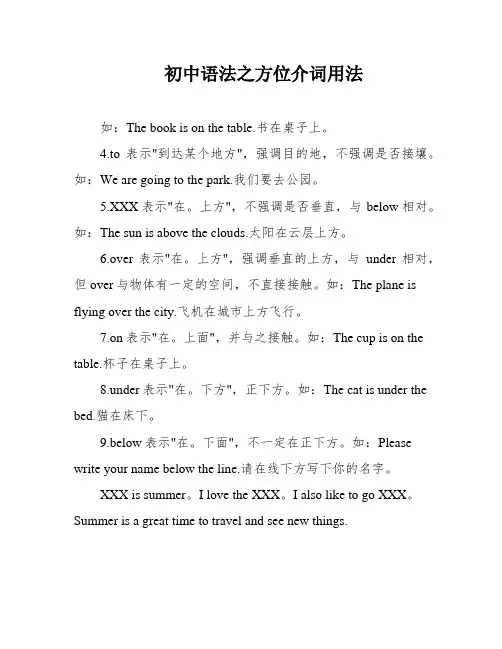
初中语法之方位介词用法如:The book is on the table.书在桌子上。
4.to表示"到达某个地方",强调目的地,不强调是否接壤。
如:We are going to the park.我们要去公园。
5.XXX表示"在。
上方",不强调是否垂直,与below相对。
如:The sun is above the clouds.太阳在云层上方。
6.over表示"在。
上方",强调垂直的上方,与under相对,但over与物体有一定的空间,不直接接触。
如:The plane is flying over the city.飞机在城市上方飞行。
7.on表示"在。
上面",并与之接触。
如:The cup is on the table.杯子在桌子上。
8.under表示"在。
下方",正下方。
如:The cat is under the bed.猫在床下。
9.below表示"在。
下面",不一定在正下方。
如:Please write your name below the line.请在线下方写下你的名字。
XXX is summer。
I love the XXX。
I also like to go XXX。
Summer is a great time to travel and see new things.XXX activities。
I also enjoy reading during the summer。
I like to sit outside and read a book in the sunshine。
It's a great way to relax and unwind。
I usually choose light and easy reads for the summer。


初中英语知识点归纳介词的用法介词是连接词与词之间,短语与短语之间,在句中表示方向、关系、时间、原因等意义的词语。
在英语中,介词的用法非常丰富多样,掌握好介词的用法,对于学习英语有着重要的意义。
下面将对初中英语中常见的介词用法进行归纳介绍。
一、表示方向、位置和距离的介词1. 在(in):在某个地方或物体内部2. 在(on):在某个平面或表面上3. 在(at):在某个地点4. 在(over):位于之上,不接触5. 在(under):位于之下,不接触6. 在(between):在两个事物之间7. 在(behind):在某物之后8. 在(in front of):在某物之前9. 在(near):在附近10. 在(around):在周围二、表示时间的介词1. 在(at):在某个具体时间点2. 在(in):在某个时间段3. 在(on):在某个具体日期三、表示原因的介词1. 因为(of):表示原因、缘故2. 由于(because of):表示原因、由于四、表示目的、用途和方式的介词1. 为了(in order to):表示目的2. 以便(in order that):表示目的3. 用(with):表示使用的手段或工具4. 通过(by):表示方式、方法5. 以(for):表示目的五、表示比较的介词1. 比较起见(than):表示比较的对象2. 和(with):与某人或某物在一起六、其它常见的介词1. 关于(about):表示涉及某一话题2. 靠(by):表示接近某人或某物3. 经过(through):表示通过某地或某事4. 编写(at):表示在某地工作或活动5. 因(as):表示角色、身份6. 例如(for example):表示举例7. 包括(including):表示包含某物以上是初中英语中常见的介词用法的归纳总结。
熟练掌握这些介词的用法,对于构建正确的句子和语法结构非常重要。
希望能对你的学习有所帮助。
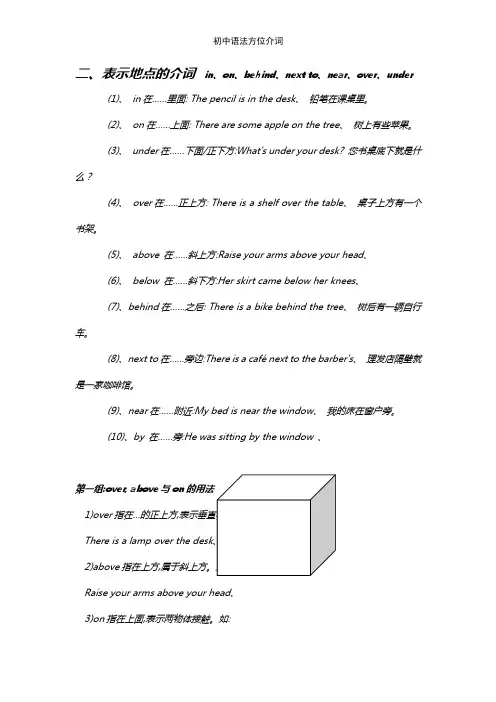
二、表示地点的介词in、on、behind、next to、near、over、under(1)、in在……里面: The pencil is in the desk、铅笔在课桌里。
(2)、on在……上面: There are some apple on the tree、树上有些苹果。
(3)、under在……下面/正下方:What's under your desk? 您书桌底下就是什么?(4)、over在……正上方: There is a shelf over the table、桌子上方有一个书架。
(5)、above 在……斜上方:Raise your arms above your head、(6)、below 在……斜下方:Her skirt came below her knees、(7)、behind在……之后: There is a bike behind the tree、树后有一辆自行车。
(8)、next to在……旁边:There is a café next to the barber's、理发店隔壁就是一家咖啡馆。
(9)、near在……附近:My bed is near the window、我的床在窗户旁。
(10)、by 在……旁:He was sitting by the window 、第一组:over, above与on的用法1)over指在…的正上方,There is a lamp over the desk2)above指在上方,Raise your arms above your head、3)on指在上面,表示两物体接触。
如:There is a cup on the table、第二组:under / below的用法:1) under在……下面/正下方:What's under your desk?2) below 在……斜下方:Her skirt came below her knees、练习:( ) 1 The boat is passing___ the bridge、A、throughB、belowC、underD、across( ) 2 Two planes are flying___ the city、A、throughB、over ,C、on , D, below( ) 3 We can see a river running to the east____ the hill、A、underB、belowC、overD、on( ) 4 Do you see the kite ___ the building、A、overB、crossC、onD、aboveC B B D第三组:in 与on表示“在……上”1,门一类——镶嵌在墙里的,用in,字画一类——挂在墙面上的,用on( ) 1 He put up a map ___ the back wall because there was a hole ___ it、A、on; onB、at; inC、on; inD、on; at( ) 2 There is a door___ the wall、A、onB、toC、ofD、in( ) 3 Any man ___ eyes______ his head can see that he's exactly like a rope、A、with; onB、with; inC、on; withD、in; with2,鸟一类落在树上的,用in;苹果一类长在树上的,用on( ) 1 There are some birds singing___ the trees、A、inB、onC、atD、from( ) 2 There are so many apples___ that tree、A、in B, on C、at D、from第四组:in /on/ to表示“接壤”B A B A B AB 在A里——用in A与B相邻(接壤)——用on A与B不相邻(不接壤)——用to( ) 1 The United States is ____ the south of Canada and ___ the east of Japan、A、to; inB、on; toC、in; besideD、at; on( ) 2 The man stood____the window, watching the boys playing outside、A、inB、byC、withD、to( ) 3 Japan lies____ the east of China、A、on B/ to C、in D、withB B BB第五组:at, in表示“在……”1)at表示较小的地点。
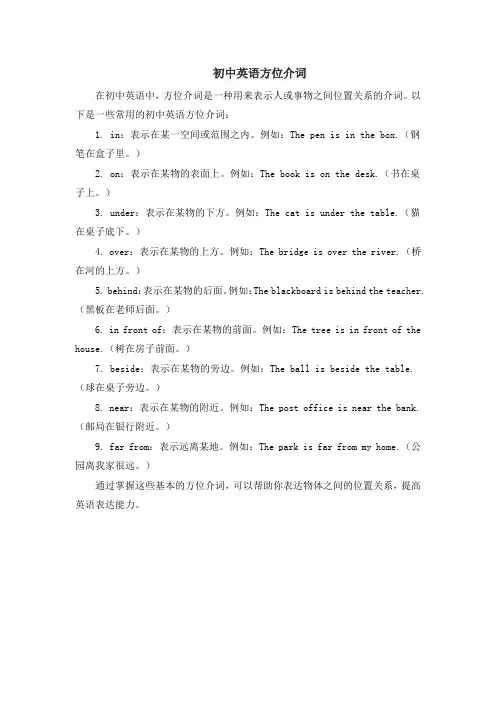
初中英语方位介词在初中英语中,方位介词是一种用来表示人或事物之间位置关系的介词。
以下是一些常用的初中英语方位介词:1. in:表示在某一空间或范围之内。
例如:The pen is in the box.(钢笔在盒子里。
)2. on:表示在某物的表面上。
例如:The book is on the desk.(书在桌子上。
)3. under:表示在某物的下方。
例如:The cat is under the table.(猫在桌子底下。
)4. over:表示在某物的上方。
例如:The bridge is over the river.(桥在河的上方。
)5. behind:表示在某物的后面。
例如:The blackboard is behind the teacher.(黑板在老师后面。
)6. in front of:表示在某物的前面。
例如:The tree is in front of the house.(树在房子前面。
)7. beside:表示在某物的旁边。
例如:The ball is beside the table.(球在桌子旁边。
)8. near:表示在某物的附近。
例如:The post office is near the bank.(邮局在银行附近。
)9. far from:表示远离某地。
例如:The park is far from my home.(公园离我家很远。
)通过掌握这些基本的方位介词,可以帮助你表达物体之间的位置关系,提高英语表达能力。
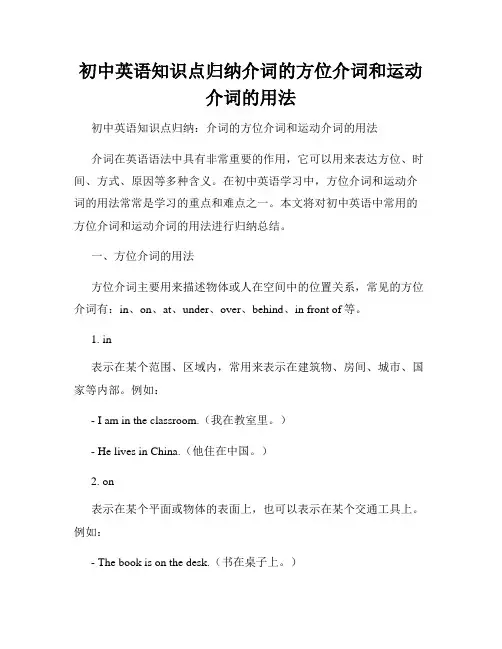
初中英语知识点归纳介词的方位介词和运动介词的用法初中英语知识点归纳:介词的方位介词和运动介词的用法介词在英语语法中具有非常重要的作用,它可以用来表达方位、时间、方式、原因等多种含义。
在初中英语学习中,方位介词和运动介词的用法常常是学习的重点和难点之一。
本文将对初中英语中常用的方位介词和运动介词的用法进行归纳总结。
一、方位介词的用法方位介词主要用来描述物体或人在空间中的位置关系,常见的方位介词有:in、on、at、under、over、behind、in front of等。
1. in表示在某个范围、区域内,常用来表示在建筑物、房间、城市、国家等内部。
例如:- I am in the classroom.(我在教室里。
)- He lives in China.(他住在中国。
)2. on表示在某个平面或物体的表面上,也可以表示在某个交通工具上。
例如:- The book is on the desk.(书在桌子上。
)- We are on the bus.(我们在公交车上。
)3. at表示在某个具体的地点或时间上。
例如:- She is waiting for me at the bus stop.(她在公交车站等我。
)- We often have dinner at home.(我们经常在家吃晚饭。
)4. under表示在某物或某个位置的下方。
例如:- The cat is under the table.(猫在桌子下。
)- The book is under the bed.(书在床下。
)5. over表示在某物或某个位置的上方。
例如:- The bird is flying over the house.(鸟在房子上方飞翔。
)- The blanket is over the child.(毯子在孩子上面。
)6. behind表示在某物或某个位置的后方。
例如:- The tree is behind the house.(树在房子后面。
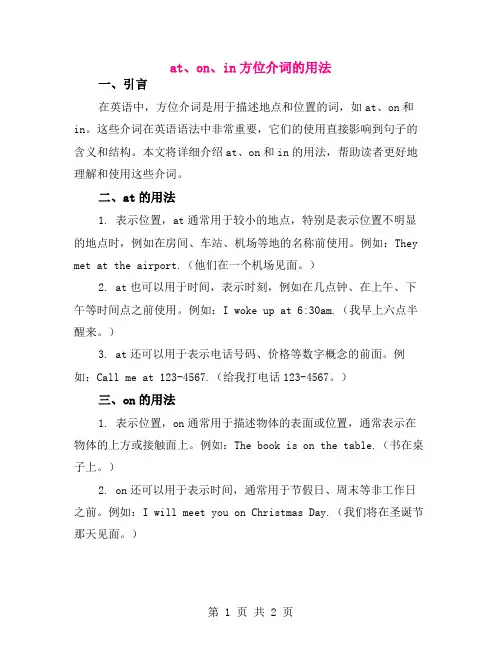
at、on、in方位介词的用法一、引言在英语中,方位介词是用于描述地点和位置的词,如at、on和in。
这些介词在英语语法中非常重要,它们的使用直接影响到句子的含义和结构。
本文将详细介绍at、on和in的用法,帮助读者更好地理解和使用这些介词。
二、at的用法1. 表示位置,at通常用于较小的地点,特别是表示位置不明显的地点时,例如在房间、车站、机场等地的名称前使用。
例如:They met at the airport.(他们在一个机场见面。
)2. at也可以用于时间,表示时刻,例如在几点钟、在上午、下午等时间点之前使用。
例如:I woke up at 6:30am.(我早上六点半醒来。
)3. at还可以用于表示电话号码、价格等数字概念的前面。
例如:Call me at 123-4567.(给我打电话123-4567。
)三、on的用法1. 表示位置,on通常用于描述物体的表面或位置,通常表示在物体的上方或接触面上。
例如:The book is on the table.(书在桌子上。
)2. on还可以用于表示时间,通常用于节假日、周末等非工作日之前。
例如:I will meet you on Christmas Day.(我们将在圣诞节那天见面。
)3. on还可以用于表示电视节目、广播节目等的播放时间。
例如:Please turn on the TV and watch the news at 7pm.(请打开电视在晚上七点观看新闻。
)四、in的用法1. 表示位置,in通常用于描述较大的地方或物体内部,例如房间、教室、学校、建筑物等场所的前面或里面。
例如:We meet in the classroom every day.(我们每天在教室见面。
)2. in还可以用于表示衣服或物体的尺寸或大小。
例如:She wears a dress in size 8.(她穿着8号的连衣裙。
)3. in也可以用于时间和年代的表述中,通常用于具体的日期或年份之前。
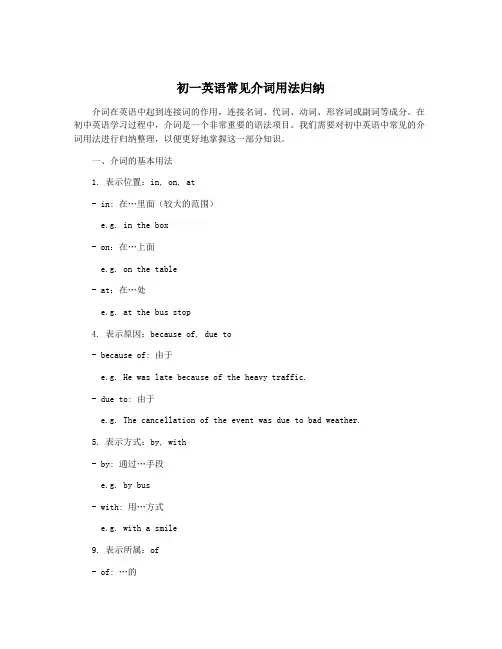
初一英语常见介词用法归纳介词在英语中起到连接词的作用,连接名词、代词、动词、形容词或副词等成分。
在初中英语学习过程中,介词是一个非常重要的语法项目。
我们需要对初中英语中常见的介词用法进行归纳整理,以便更好地掌握这一部分知识。
一、介词的基本用法1. 表示位置:in, on, at- in: 在…里面(较大的范围)e.g. in the box- on:在…上面e.g. on the table- at:在…处e.g. at the bus stop4. 表示原因:because of, due to- because of: 由于e.g. He was late because of the heavy traffic.- due to: 由于e.g. The cancellation of the event was due to bad weather.5. 表示方式:by, with- by: 通过…手段e.g. by bus- with: 用…方式e.g. with a smile9. 表示所属:of- of: …的e.g. the hat of the boy2. look forward to: 期待e.g. I am looking forward to the summer vacation.5. be interested in: 对…感兴趣e.g. Amy is interested in learning Chinese.三、常见介词错误用法及纠正1. 错误用法:depend of正确用法:depend one.g. We depend on each other.通过以上的介词错误用法及纠正,我们可以更清晰地了解该如何正确使用这些介词。
四、综合练习通过上述的综合练习,可以帮助大家更好地掌握介词用法。
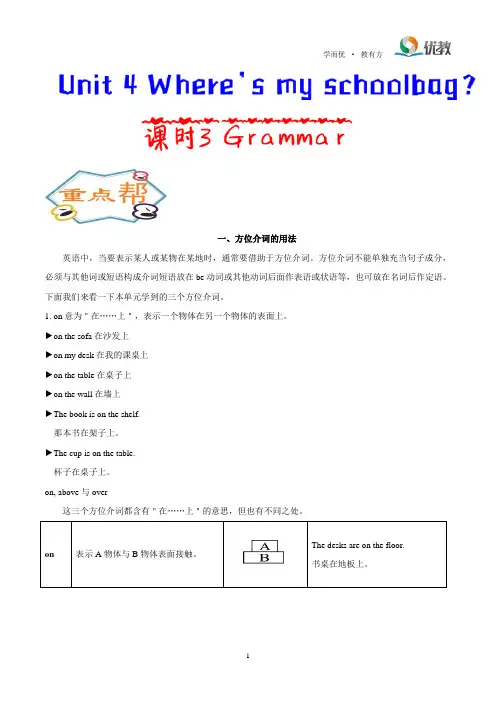
一、方位介词的用法英语中,当要表示某人或某物在某地时,通常要借助于方位介词。
方位介词不能单独充当句子成分,必须与其他词或短语构成介词短语放在be动词或其他动词后面作表语或状语等,也可放在名词后作定语。
下面我们来看一下本单元学到的三个方位介词。
1. on意为"在……上",表示一个物体在另一个物体的表面上。
►on the sofa在沙发上►on my desk在我的课桌上►on the table在桌子上►on the wall在墙上►The book is on the shelf.那本书在架子上。
►The cup is on the table.杯子在桌子上。
on, above与over这三个方位介词都含有"在……上"的意思,但也有不同之处。
The desks are on the floor.on 表示A物体与B物体表面接触。
书桌在地板上。
above表示A物体位置高于B物体,但不一定在其正上方,也不接触B物体。
He lifted his hands above his head. 他将双手举过头顶。
over表示A物体在B物体的垂直正上方,多暗指悬空。
The kite is right over the house. 风筝在房子的上方。
2. in意为"在……里面",指的是一个物体在另一个物体的内部。
►in the room 在房间里►in the box 在盒子里►in her backpack 在她的背包里►The dictionary is in the schoolbag.字典在书包里。
►My pen is in the pencil box.我的钢笔在铅笔盒里。
(1)be in 在家,相当于be at home,常用于打电话。
►—Hello. This is Mary. Is Lucy in?您好,我是玛丽,露西在家吗?—Sorry, she’s at school.对不起,她在学校。
(2)in+颜色/衣物,表示"穿着;戴着"。
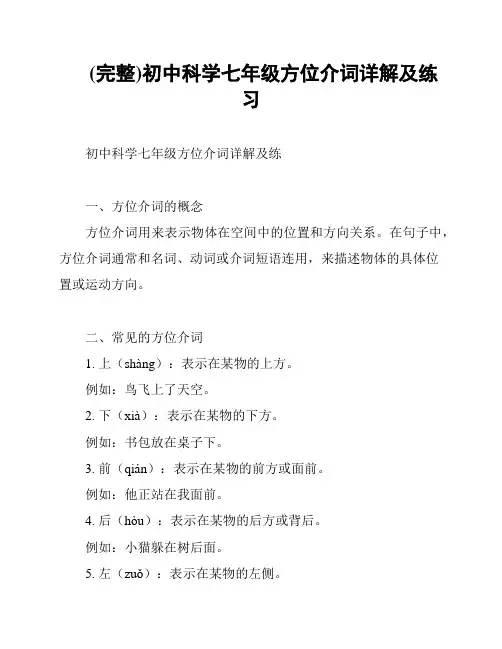
(完整)初中科学七年级方位介词详解及练习初中科学七年级方位介词详解及练一、方位介词的概念方位介词用来表示物体在空间中的位置和方向关系。
在句子中,方位介词通常和名词、动词或介词短语连用,来描述物体的具体位置或运动方向。
二、常见的方位介词1. 上(shàng):表示在某物的上方。
例如:鸟飞上了天空。
2. 下(xià):表示在某物的下方。
例如:书包放在桌子下。
3. 前(qián):表示在某物的前方或面前。
例如:他正站在我面前。
4. 后(hòu):表示在某物的后方或背后。
例如:小猫躲在树后面。
5. 左(zuǒ):表示在某物的左侧。
例如:我坐在他的左边。
6. 右(yòu):表示在某物的右侧。
例如:妈妈在我右边开车。
7. 中间(zhōng jiān):表示在某物的中间位置。
例如:篮球在两个人中间跳动。
三、方位介词的练1. 请写出下面句子中需要填写方位介词的地方:- 猫躲在椅子()面。
- 学生们排成一个长队,小明站在队()。
- 太阳从山()升起来了。
- 妹妹的书包放在桌子()。
- 老师站在黑板()。
2. 请结合实际情境,用方位介词造句,至少写出五个句子。
四、总结本文介绍了初中科学七年级方位介词的概念和常见用法,并提供了方位介词的练题,旨在帮助学生掌握方位介词的应用。
通过练,学生可以更好地描述物体的位置和方向关系。
以上是初中科学七年级方位介词详解及练习的内容,希望对您有帮助。
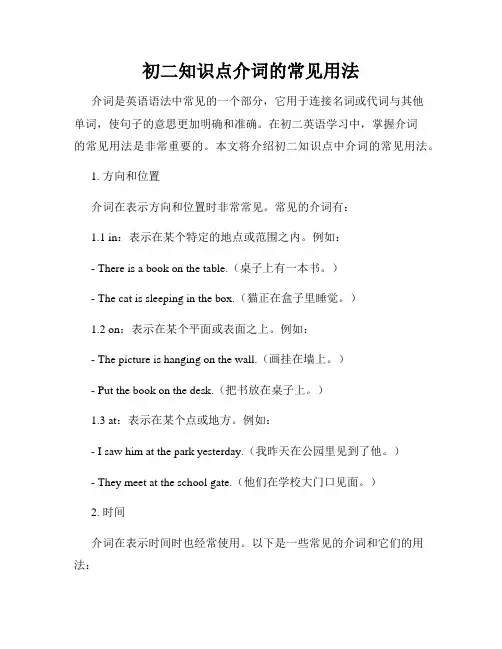
初二知识点介词的常见用法介词是英语语法中常见的一个部分,它用于连接名词或代词与其他单词,使句子的意思更加明确和准确。
在初二英语学习中,掌握介词的常见用法是非常重要的。
本文将介绍初二知识点中介词的常见用法。
1. 方向和位置介词在表示方向和位置时非常常见。
常见的介词有:1.1 in:表示在某个特定的地点或范围之内。
例如:- There is a book on the table.(桌子上有一本书。
)- The cat is sleeping in the box.(猫正在盒子里睡觉。
)1.2 on:表示在某个平面或表面之上。
例如:- The picture is hanging on the wall.(画挂在墙上。
)- Put the book on the desk.(把书放在桌子上。
)1.3 at:表示在某个点或地方。
例如:- I saw him at the park yesterday.(我昨天在公园里见到了他。
)- They meet at the school gate.(他们在学校大门口见面。
)2. 时间介词在表示时间时也经常使用。
以下是一些常见的介词和它们的用法:2.1 at:表示具体的时间点。
例如:- The party is at 7 o'clock.(晚会在7点举行。
)- We have English class at 9:30 every morning.(我们每天早上9点半上英语课。
)2.2 on:表示具体的日期或星期。
例如:- We have a meeting on Monday.(我们星期一开会。
)- His birthday is on September 10th.(他的生日是9月10日。
)2.3 in:表示一个较长的时间段。
例如:- I will go on vacation in July.(我将在七月份去度假。
)- We have a holiday in winter.(我们在冬季放假。
初中英语——“方位”介词在初中英语中,有许多表示事物存在的方向和位置的介词,我们称之为方位介词。
其中有些方位介词的意义比较接近,在用法上很难区分,如on, over, above 都有“在……之上”的意思,但含义却不尽相同。
我们可以用三个图示配以简短的文字叙述来说明这三个介词的不同用法。
部分方位介词用图示的方法归纳列举如下:◆几组方位介词的区别A. 方位介词in, on, to的区别:in表示“在……范围内”,还表示“在…之中” Chongqing lies in the southwest of China.✓on表示“与……毗邻,接壤”Canada lies on the north of America.✓to表示方位,不接壤Hunan lies to the east of Zhejiang.B. 表示地点位置的介词(at, in, on, to)✓at 用于小地方,at school, at home✓in 用于大地方,in Beijing, in China✓on在……上面,on the map, on the table✓to到……to ChongqingC. above, over, on✓above在……上方(高过另一个物体,不强调垂直)✓over在……上方(垂直上方)✓on在……上面(物体表面有接触)D. below, under✓under在……下(正下方)The cat lies under the chair.(正下方)✓below在……下(不一定是正下方)The cat lies under the chair.(不是正下方)E. in front of, in the front of 在……的前面✓in front of 在外部的前面,两个东西是独立的——相反的是behind✓in the front of在内部的前面,属于其中的一部分——相反的是at the back ofF. beside, near, by✓beside在旁边✓near在附近✓by在附近,非常靠近G. between, among✓between 在……之间(指两者)✓among(指三者或三者以上)●常见方位介词短语由介词in构成的方位介词短语1、in the front 在前面2、in the front row 在前排3、in the back row 在后排4、in the third row 在第三排5、in front of... 在...前面(范围之外)6、in the front of... 在...前部(范围之内)7、in the middle在中间8、in the street在街上9、in the middle of...在中间10、in the tree在树上(指飞鸟等外来物)由介词at构成的方位介词短语1、at the front of...在...所在范围的前一部分2、at the back of...在...所在范围的后一部分3、at the foot of...在...脚下4、at the top of...在...顶部5、at the end of...在...尽头(尾部)6、at the head of...在...前头7、at the(school)gate在(校)门口8、at the station 在车站9、at No.2 Chang’an Road在长安路2号10、at my uncle’s 在我叔叔家11、at home在家12、at the doctor’s在医务室/在诊所由介词on构成的方位介词短语1、on the right/left在右(左)边2、on one’s right/left在某人的右(左)边3、on the desk/table在课桌/桌上4、on the right-hand/left-hand side在右/左手边5、on the blackboard在黑板上6、on/in the wall在墙上/里7、on the paper在纸上8、on the tree在树上(指树上长的,结的东西) 其它介词构成的方位介词短语1、next to靠近/贴近2、beside the desk在课桌旁3、behind the door在门后4、under the bed在床下5、near the window靠近窗户6、outside the gate在门外。
初中英语语法总结:方位介词(有答案)A。
XXX初中英语语法总结:方位介词方位介词用于描述物体或人在空间中的位置关系,常见的有in、on、behind、next to、near、over、under等。
1.in表示在某个物体内部,如XXX可以改为XXX XXX XXX.2.on表示在某个物体的表面,如There are some apples on the tree.可以改为The apples are on the surface of the tree.3.under表示在某个物体的下面或正下方,如What's under your desk?可以改为XXX?4.over表示在某个物体的正上方,如There is a shelf over the table.可以改为There is a shelf above the table.5.XXX表示在某个物体的斜上方,如Raise your arms above your head.可以改为Lift your arms at an angle above your head.6.below表示在某个物体的斜下方,如XXX可以改为XXX.7.XXX表示在某个物体的后面,如There XXX.可以改为There is a bike at the back of the tree.8.XXX表示在某个物体的旁边,如There is a café next to the barber's.可以改为There is a café beside the barber's.9.near表示在某个物体的附近,如My bed is near the window.可以改为My bed is close to the window.XXX表示在某个物体的旁边,如He was XXX.可以改为He was sitting next to the window.练:1.XXX passing ___ the bridge.A。
初中英语语法总结:⽅位介词(有答案)初中英语语法总结:⽅位介词表⽰地点的介词in、on、behind、next to、near、over、under(1). in在……⾥⾯:The pencil is in the desk. 铅笔在课桌⾥。
(2). on在……上⾯:There are some apple on the tree. 树上有些苹果。
(3). under在……下⾯/正下⽅:What's under your desk? 你书桌底下是什么?(4). over在……正上⽅:There is a shelf over the table. 桌⼦上⽅有⼀个书架。
(5). above 在……斜上⽅:Raise your arms above your head.(6). below 在……斜下⽅:Her skirt came below her knees.(7).behind在……之后:There is a bike behind the tree. 树后有⼀辆⾃⾏车。
(8).next to在……旁边:There is a café next to the barber's. 理发店隔壁是⼀家咖啡馆。
(9).near在……附近:My bed is near the window. 我的床在窗户旁。
(10).by 在……旁:He was sitting by the window.第⼀组:over, above和on的⽤法1)over指在…的正上⽅,表⽰垂直在上。
如:There is a lamp over the desk.2)above指在上⽅,属于斜上⽅。
如:Raise your arms above your head.3)on指在上⾯,表⽰两物体接触。
如:There is a cup on the table.第⼆组:under / below的⽤法:1) under在……下⾯/正下⽅:What's under your desk?2) below 在……斜下⽅:Her skirt came below her knees.练习:( ) 1 The boat is passing___ the bridge.A. throughB. belowC. underD. across( ) 2 Two planes are flying___ the city.A. throughB. overC. on D, below( ) 3 We can see a river running to the east____ the hill.A. underB. belowC. overD. on( ) 4 Do you see the kite ___ the building.A. overB. crossC. onD. above参考答案C B B D第三组:in 和on表⽰“在……上”门⼀类——镶嵌在墙⾥的,⽤in字画⼀类——挂在墙⾯上的,⽤on( ) 1 He put up a map ___ the back wall because there was a hole ___ it. A. on; on B. at; in C. on; in D. on; at ( ) 2 There is a door___ the wall.A. onB. toC. ofD. in( ) 3 Any man ___ eyes______ his head can see that he's exactly like a rope.A. with; onB. with; inC. on; withD. in; with鸟⼀类落在树上的,⽤in;苹果⼀类长在树上的,⽤on( ) 1 There are some birds singing___ the trees.A. inB. onC. atD. from( ) 2 There are so many apples___ that tree.A. in B, on C. at D. from第四组:in /on/ to表⽰“接壤”第四组:in /on/ to表⽰“接壤”B A B AB 在A⾥——⽤in A和B相邻(接壤)——⽤onA BA和B不相邻(不接壤)——⽤to练习( ) 1 The United States is ____ the south of Canada and ___ the east of Japan.A. to; inB. on; toC. in; besideD. at; on( ) 2 The man stood ____the window, watching the boys playing outside. A. in B. by C. with D. to ( ) 3 Japan lies____ the east of China.A. on B/ to C. in D. with参考答案B B B B第五组:at, in表⽰“在……”1)at表⽰较⼩的地点。
七年级英语之-- 方位介词图示“方位”介词介词的种类很多。
在初中英语中,有许多表示事物存在的方向和位置的介词,我们称之为方位介词。
如in (在……里),behind (在……后面在……后面),down (向下向下)等等。
其中有些方位介词的意义比较接近,在用法上很难区分,如on, over, above 都有“在……之上”的意思,但含义却不尽相同。
我们可以用都有“在……之上”的意思,但含义却不尽相同。
我们可以用三个图示配以简短的文字叙述来说明这三个介词的不同用法。
三个图示配以简短的文字叙述来说明这三个介词的不同用法。
on over above 通过这种方法,我们很容易掌握这三个介词的用法。
现将初中英语教材中的部分方位介词用图示的方法归纳列举如下: 介 词 图 示 意 义 例 句1 in 在……之内在……之内The students are reading in the classroom. 学生们在教师里读书。
学生们在教师里读书。
2 on 在……上面在……上面The boat is on the river. 那条船在河上。
那条船在河上。
3 over 在……(正)上方上方There are several bridges over the river. 河上有好几座桥。
河上有好几座桥。
4 under 在……(正)下方下方The boat sailed under the bridge. 船在桥下行驶。
船在桥下行驶。
5 obove 在……上方在……上方The plane flew above the clouds. 飞机在云上飞行。
飞机在云上飞行。
6 below 在……下方在……下方 The sun sinks below the horizon. 太阳沉没在地平线下。
太阳沉没在地平线下。
7 By 在……旁边在……旁边Our house is by the river. 我们的房子在河边。
我们的房子在河边。
方位介词的用法总结
方位介词是指表示“位置、方向、距离”等方面的介词,在英语中常用的有on, in, at, up, down, to等。
这些介词不仅在语法中具有重要地位,也在交际中是不可或缺的。
在这里,我们来总结一下方位介词的用法。
1. On
On是一个常用的方位介词,表示在某个平面或表面上。
例如:on the table(在桌子上)、on the wall(在墙上)、on the floor(在地板上)等。
2. In
3. At
At表示一个准确的点或位置。
例如:at the bus station(在汽车站)、at the front door(在前门)等。
4. Up
Up表示朝上的方向。
例如:look up(向上看)、climb up(爬上)等。
5. Down
Down表示朝下的方向。
例如:fall down(摔倒)、go down(下降)等。
6. To
总之,方位介词在英语中的使用是非常广泛的,了解这些介词的用法,可以更清楚地表达自己的意思。
英语中方位介词用法
介词是一种用来表示词与词, 词与句之间的关系的词。
在句中不能单独作句字成分。
介词后面一般有名词代词或相当于名词的其他词类,短语或从句作它的宾语。
介词和它的宾语构成介词词组,在句中作状语,表语,补语,定语或介词宾语。
at ,in, on, to
at (1)表示在小地方; (2)表示“在……附近,旁边”
in (1)表示在大地方; (2)表示“在…范围之内”。
on 表示毗邻,接壤
to 表示在……范围外,不强调是否接壤
及时练
1.He arrived _____ the station at ten.
2.He is sitting ______ the desk.
3.He arrived _____ Shanghai yesterday.
4.Jiangsu lies ________ the east of China.
5.Russia live ______ the north of China.
6.Fujian is ________ the south of Jiangsu Province.
2)above, over, on 在……上
above 指在……上方,不强调是否垂直,与below相对;
over指垂直的上方,与under相对,但over与物体有一定的空间,不直接接触。
on表示某物体上面并与之接触。
1.The bird is flying above my head.
2.There is a bridge over the river.
3.He put his watch on the desk.
3)below, under 在……下面
under表示在…正下方
below表示在……下,不一定在正下方
There is a cat under the table.
Please write your name below the line.
方位介词
1. at表示"在......处",一般指较小的比较具体的地点。
如: He isn't at school. He is at home. 他不在学校,他在家。
2. in表示"在......内部;在......里面"的意思。
如: What is in the box? 盒子里有什么?
3. on表示"在某物的上面",但两者互相接触。
如:My books are on that table. 我的书在那张桌子上。
on the wall 在墙上
4. under表示"在某物垂直的正下方",两者之间不接触。
如:My cat is under my chair. 我的猫在我的椅子下。
5. behind表示"在某物体的后面"。
如:The broom is behind the door. 笤帚在门后。
6. in front of表示"在......的前面",正好与behind相反。
如: There are some big trees in front of our classroom. 我们教室前面有几棵大树。
7. near表示"在某物体的附近",意为"接近、靠近"。
如: The ball is near the door. 球在门旁边。